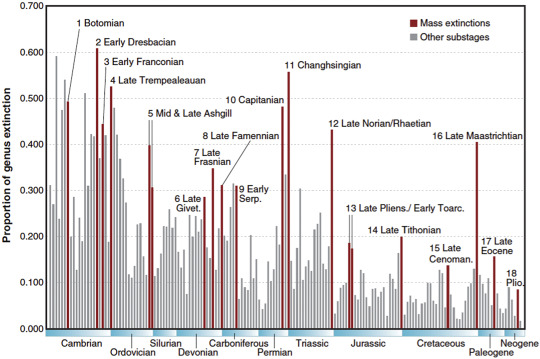#EVOLUTION
Explore tagged Tumblr posts
Text
Pedagogical evolution techniques. Amazing.
what annoys me about explaining evolution to people who don’t think it’s real is that everyone’s idea of how it works seems to be from this

Whereas the reality is far more like

62K notes
·
View notes
Text
Continuing with the late Cretaceous marine environment of southern Sweden, the huge mosasaur Tylosaurus ivoensis tries an attack from below.

#dinosaur#illustration#paleoart#paleontology#paleoillustration#paleoblr#palaeoblr#art#palaeontology#mosasaurus#tylosaurus#sweden#palaeoart#paleoartist#jurassic world#late cretaceous#prehistoric planet#scicomm#sci art#natural history#earth history#evolution#sea reptile
242 notes
·
View notes
Text

𐠒
#777lx#jdm#jdmcars#cars#car#mitsubishi#mitsubishi evo#evo#evolution#spec evo#rain#Japan#Japanese#photography
95 notes
·
View notes
Text
Surveying Mass Extinctions - Part 1

Patterns of Extinction, taken from Marshall, 2023
Mass extinctions are when a large sample of biological clades undergoes a geologically-brief period of die-off that is statistically higher than the background rate of extinction (Marshal, 2023). Most of the organisms that have ever lived died out through the regular trials of natural selection, but on occasion the Earth's conditions changed so rapidly that many different species could not adapt in time.
These extinction events were some of the driving forces that shaped the evolution of life, typically be "reshuffling the deck" or weeding out a few key taxa, thus paving the way for new life to flourish. So what are these mass extinctions and just how did they change the world?
In this post, I will be providing a brief account of our current understanding of each extinction event: when they occured, their causes, and the victims and survivors. As you'll come to discover, the pop-science view of "five big mass extinctions" is complicated by evidence suggesting that some singular events are best seen as two or three, while others have been neglected by mainstream coverage.
Great Oxidation Event
When? - ~2.4-2 Billion Years Ago (Paleoproterozoic Era)
Cause - When photosynthesizing bacteria evolved the Earth's atmosphere did not contain free oxygen, being mainly CO2 and nitrogen. The process of photosynthesis converts sunlight into sugars which takes in CO2 and expels oxygen. The abundance of prokaryotes engaged in this chemistry released oxygen in enormous quantities. While much of it initially was absorbed by dissolved iron on the seabed, the rest rose into the atmosphere. This increase in free oxygen changed the air content and triggered global cooling (perhaps spawning glacial periods).
Victims - It has been generally proposed that the newly oxygenated atmosphere had negative effects on the then-common anaerobic bacteria & archaea, who should have suffered a mass extinction due to oxygen poisoning. While direct evidence for this had been lacking for some time, recent geochemical work suggests "a rapid reduction in primary productivity of >80%" that "imply a collapse in primary productivity" (Hodgskiss, 2019).
Survivors - Aerobic prokaryotes would have flourished in the aftermath of the Oxidation Event, while anaerobic forms would have migrated and adapted into areas still free of oxygen. It has been argued that the evolution of eukaryotes was spurred by the changes, but so-far this is controversial (Fakhraee, 2013).
End-Ediacaran Extinction Event
When? - ~541 Million Years Ago
Cause - An event little-studied and sometimes doubted (MacLeod, 2015), recent work posits that Ediacaran communities were generally low-diversity and "quiet"-ecologically (Darroch, et al. 2015). The gradual evolution of new animal life (a.e. not an explosion as typically described) at the bridge of the Cambrian corresponds with ecosystem-engineering that simply pushed many of the Ediacaran species to extinction.
Victims - The mysterious "Ediacaran fauna": a collection of soft-bodied, basal-animals. Dipleurozoans (e.g. Dickinsonia), trilobozoans, and cephalozoans (e.g. Spriggina) went extinct.
Survivors - Petalonamids like Charnia, frond-shaped stem-eumetazoans (animals with tissues, nerves, and muscles) were the only classic Ediacaran forms to make it through. Genetic and fossil evidence shows that the ancestors of many living animal groups were around at the time: they likely contributed to the extinction in the first place. This event marks the transition towards the so-called "Cambrian Fauna" of marine invertebrate biodiversity that characterized the next 40 million years.

Archaeocyathids (Stanton F. Fink, CC BY 2.5)
End-Botomian Extinction Event
When? - ~513-509 Million Years Ago (Middle Cambrian Period)
Cause - Recent work points to roughly 4-pulses of the "Cambrian Explosion" (Benton, 2023). By 513 MYA, this had ceased, and marine invertebrate faunas were abundant in the world's oceans. Evidence from sulphur isotopes suggests that volcanic eruptions in present-day north Australia led to a rise in CO2 and anoxic conditions on the continental shelves (Hough, et al. 2006). Such shifts are prime conditions for disrupting and destroying reef ecosystems; the early Cambrian saw the rise of archaeocyathids, reef-building relatives of sponges, that supported marine communities.
Victims - The last of the petalonamids died out. Archaeocyathids and the reefs they built perished. There were losses among brachiopods (obolellates died out), trilobites (the spiny olenellids in particular), and it has been proposed that the halkieriids & Wiwaxia - potential stem-mollusks - were victims but there are some issues with stratigraphic-dating and there is tentative evidence they survived into the Ordovician.
Survivors - Paleontologists recognize a "Cambrian Dead Interval" following the Botomian in which marine biodiversity was low for a while (Brannen, 2017). The climate was fairly cool and geologists have found evidence of coastal ice within tropical zones that likely kept surviving invertebrates in check (Runkel, et al. 2010). For context, the Burgess Shale community is thought to have come into being following the extinction event.
Early Dresbachian & Franconian Extinction Events
When? - ~502 & 497 Million Years Ago (Late Cambrian Period)
Cause - A series of extinction pulses that are little known. Attention has been drawn to the Steptoean Positive Carbon Isotope Excursion or SPICE, a return to anoxic conditions due this time to coastal upwelling (Bond & Grasby, 2017).
Victims - Trilobites experienced particularly high losses, with the flat-bodied redlichiids dying out and the genera-records of North America and Australia lowering over time (Bond & Grasby, 2017).
Survivors - Marine invertebrate communities remained low in diversity compared to earlier times.
Cambrian-Ordovician Extinction Event
When? - ~485 Million Years Ago (Late Trempealeauan Age)
Cause - The culmination of punctuated Cambrian extinctions, with eruptions in southern Africa contributing to even-lower anoxic conditions in the oceans.
Victims - Among other invertebrate losses, trilobites were reduced in clade-diversity to such levels that they never recovered from their peak in the Cambrian.
Survivors - Despite the losses among trilobites, modelling suggests that a few clades may have entered symbiotic relationships with sulphur-bacteria, ensuring their survival in hard times (John & Walker, 2016). Brachiopods radiated into entirely new groups following the extinction event, while conodonts (lamprey-like early vertebrates) truly began to flourish afterwards. Evidence from Morocco and the United Kingdom show that some of the Cambrian marine fauna survived into the Ordovician (Botting, et al. 2023).

Anatomy of a Bryozoa zooid (SLP456, CC BY-SA 4.0)
Late Ordovician Extinction Events
When? - ~445-444 Million Years Ago (Mid & Late Ashgill Epochs)
Causes - Following the various Cambrian extinctions, marine invertebrate faunas underwent a radical shift called the Great Ordovician Biodiversification Event: the new "Paleozoic Fauna" constituted mainly of brachiopods, bryozoa, echinoderms, graptolites, and cephalopods and remained in place for roughly 230 million years. Two pulses of extinction are recognized at the end of the period, having commonly been attributed to the rise in the Gondwanan Ice Sheet in the southern hemisphere (a sort of proto-Antarctica), which caused a drop in coastal sea levels while simultaneously chilling the tropical oceans. Additional factors have been proposed, including a convergence in volcanic activity that reduced oxygen-levels in the seas and further cooled the climate. Recovery of black shales in North Africa and Arabia indicate that this rapid icehouse cooling was just as rapidly followed by severe greenhouse warming (Brannen, 2017). This is not consensus, however, and other proposals have been work-shopped including volcanic global warming (with no glaciation involved) and extraterrestrial events (Bond & Grasby, 2017, Benton 2023).
Victims - The first wave of extinctions primarily hit free-swimming and planktonic forms, and "multi-branched" graptolites were hit very hard. The second wave of extinctions was less severe, but overall both periods saw significant loses in sessile (fixed to the ocean floor) organisms (including crinoids, "inarticulate" brachiopods, and bryozoa). The iconic giant nautiloid cephalopods like Endoceras died out.
Survivors - Evidence points to a lessening in regional marine faunal diversity but a broadening of geographic ranges for particular organisms. Trilobites, brachiopods, and bryozoa did survive, but now they were a shell of their former variety. Perhaps the most remarkable post-catastrophe boost was in the early vertebrates: jawless fishes had evolved in the Cambrian, but following the Ordovician they radiated, developed paired fins, and gave rise to jawed fishes or gnathostomes.
Silurian Extinctions
When? - Between 432 and 420 Million Years Ago
Cause - A series of three little-known pulses of extinction during the Middle and Late Silurian Periods. The first (the Ireviken Event) seems to correspond to deep-ocean anoxia, while the second and final (the Mulde & Lau events) follow a drop in sea levels
Victims - In the strata in which these extinction events occurred, there were significant losses among trilobites, graptolites, and conodonts. There is evidence to suggest a fall in plantkonic-productivity (Bond & Grasby, 2017)
Survivors - Rugose and tabulate reef-builders remained unaffected
Zlichov, Daleje, Chotec, Kačák & Taghanic Extinctions
When? - Between 410 and 386 Million Years Ago
Cause - Five minor pulses of regional extinctions throughout the Early and Middle Devonian Periods, attributed to sea level rises and oceanic anoxia
Victims - Goniatites and agoniatitids, relatives of ammonites, suffered losses, as did trilobites, conodonts, brachiopods, bryozoa, and a little-known group of lophophorates called tentaculitids. An additional group of reef-builders - the stromatoporoid sponges - also experienced declines along with certain rugose and tabulate coral taxa
Survivors - While there were losses among marine invertebrate clades, no major groups died off altogether.

Devonian Reef, showcasing rugose & tabulate corals (James St. John, CC BY 2.0)
Late Devonian Extinctions
When? - Between 372.2-358.9 Million Years Ago
Cause - Long recognized as a singular extinction event (and one of the "Big Five", the Late Devonian is better understood to have encapsulated perhaps two pulses of extinction. The first was largest of the two, the Kellwasser Event, followed millions of years later by the Hangenerg Event which closed out the period. There have been issues with poorly-dated strata, and this has led to conflicting data suggesting times of global cooling and warming (Brannen, 2017). A leading contender for the two pulses had been the rise and spread of terrestrial plants: the evolution of root-systems lead to widespread weathering of rocks and soil run-off, which triggered a particularly deadly combination of ocean anoxia and poisonous planktonic blooms akin to red-tides (Smart, et al. 2023). There is also evidence to suggest volcanic activity played a role in at least the Kellwasser Event (Benton, 2023).
Victims - This was the peak for reef-building organisms during the Devonian, and these events led to such a great loss in rugose & tabulate corals, with the stromatoporoids going extinct, that these ecosystems never recovered. Overall marine life suffered tremendous extinctions across invertebrate and vertebrates groups. Trilobite diversity was cleaved once again, e.g. lichids, corynexochids, harpetids, odontopleuridans, and phacopids. Cystoid echinoderms went extinct. Pentamerid brachiopods went extinct. Most of the jawless fishes and all of the jawed and armored "placoderms" went extinct (think of Dunkleosteus & Bothriolepis).
Survivors - Trilobites only barely made it through the extinction event, with only the proetid clade surviving. Bivalve and gastropod mollusks - originally minor elements of the marine fauna - began to experience a rise and spread of variety. Fish diversity, though severely depleted, did eventually recover under new adaptive radiations, particularly among cartilaginous and lobe-finned groups. There is little evidence to suggest that land floras and faunas were effected by the changes.
Serpukhovian Extinction
When? - Between 330 and 325 Million Years Ago
Cause - A significant mass extinction at the end of the Mississippian or Early Carboniferous Period. Recent isotopic studies point to (you guessed it) deepwater anoxia spreading to shallow coastal waters (Hu, 2022).
Victims - The Mississippian seas were originally home to massive groves of crinoid forests supplemented by surviving rugose corals, but following the Serpukhovian Event these environments experienced a major turnover. Major brachiopod groups suffered losses, as did conodonts.
Survivors - Marine invertebrate faunas remained low throughout the rest of the Carboniferous Period.
Carboniferous Rainforest Collapse
When? - ~305 Million Years Ago
Cause - The famous coal forests full of giant arthropods and reptilian-esque stem-amphibians were only a Pennsylvanian or Later Carboniferous phenomena. The fossil record points to a widespread span of these forests across present-day Europe and North America, which at the time strode the equator (Benton, 2023). On the paleo-continent of Gondwana in the southern hemisphere, glaciers spread and facilitated a massive drop in global sea levels. The coal forests were situatied in low-lying wetlands, and so the great majority of these environments collapsed as the world cooled and dried.
Victims - Coal forests were primarily formed of lycopods, which suffered losses and declines. Within the forests, early tetrapods experienced a drop in species richness (Dunne, et al. 2018).
Survivors - There is evidence of a transition in flora between the coal forest lycopods and tree ferns, which in turn led to a shift in the development of "fixed-channel" floodplains and river systems (Davies & Gibling, 2011). Despite the declines, coal forests did survive in small pockets, with ecological members like Lepidodendron and the giant griffinflies making it to the end of the Permian Period.
Olson's Extinction
When? - 273 Million Years Ago
Cause - Recent research supports a small extinction event occuring at the end of the Early Permian Period (Brocklehurst, 2020). The causes are still being studied, although a rise in global temperatures has been implicated based on the taxa that were effected, whom primarily inhabited wetter environments.
Victims - Among the synapsid "protomammals", most of the early-branching forms went extinct, including edaphosaurids, ophiacodonts, and sphenacodontids (e.g. Dimetrodon). Reptiliomorphs and temnospondyls also experiences losses, as did the fern-dominated floras they relied upon.
Survivors - Therapsids, derived synapsids with more mammalian-traits survived and radiated into several new clades. Seed-bearing plants, including ancestral conifers and ginkgoes, survived and later flourished.

Carnivorous gorgonopsian preying on herbivorous pareiasaurs (Dmitry Bogdanov, CC BY 3.0)
The Great Dying or End Permian Extinctions
When? - Between 259 and 251 Million Years Ago
Causes - Statistically this was the largest mass extinction event in Earth's history, but recent work points to it unfolding in two massive pulses: the Capitanian Event and the Changhsingian Event (Bond & Grasby, 2017; Benton, 2023). An increase in research over the last decade has shed new light on the multifaceted causes of this extinction event. Both events were encapsulated by a spike in volcanic emissions, with the Capitanian perhaps centered on the Emeishan Traps eruptions of South China and the Changhsingian centered on the Siberian Traps eruptions of Russia. Such activity lead to spikes in ocean anoxia and acidification, and the Changhsingian in particular had additional baggage. The Siberian Traps emissions were enormous, on the order of 1.8 million cubic miles of lava flows which are preserved today as flood basaltic deposits 1,300-9,840 feet thick (MacLeod, 2015). Such devastating volcanic activity over several hundred million years pushed C02 levels in the atmosphere and blotted out the sun, triggering a runaway greenhouse effect. This global warming was assisted by the melting of deep ocean methane and underground salts, and the release of sulfates from the volcanoes (which chipped away at the ozone layer). The oceans became choked with acid and were heated to 93-104°F (Benton, 2023), and the land was boiling and suffocating under an sky filled with 2,500 ppm of CO2 (Wu, et al. 2021). The only organisms to really flourish were sulphur-eating bacteria.
Victims - Life across all clades experienced declines and total extinctions, hence the designation of "The Great Dying". In the seas, all the trilobites, rugose & tabulate corals, eurypterids ("water scorpions"), goniatites, and strophomenid & orthid brachiopods went extinct. Fusulinid foraminifera (forams are shelled amoeba-like microbes) went extinct. Receptaculitid marine algae went extinct, and there were sharp losses among land plants, including the Glossopteris forests. This is the only major extinction event to affect insects, and five clades died out including the paleodictyopterids and giant griffinflies (meganisopterans). Many groups of therapid protomammals went extinct, including gorgonopsians, dinocephalians, and biarmosuchians. The parareptiles - early diverging forms with the anapsid-skull condition - also mostly perished. Lepospondyls, amphibian-like stem reptiles, went extinct, while only some temnospondyl groups perished (e.g. the gharial-like archegosaurids).
Survivors - It is estimated that life took several million years to recover, and the earliest Mesozoic Era was for the most part an empty place for some time. Surviving marine invertebrates were all smaller than their ancestors, and many aquatic vertebrates may have survived the devastation by retreating to the deeper ocean depths. Overall, therapsids, reptiles, and temnospondyls survived and would jockey for available land and freshwater niches, the outcome of which would be determined by further catastrophies.
This survey will conclude with the Mesozoic and Cenozoic mass extinctions in the next post...
Book Citations
Michael J. Benton. Extinctions (Thames & Hudson, 2023)
Peter Brannen. The Ends of the World (Ecco, HarperCollins, 2017)
Norman MacLeod. The Great Extinctions (Firefly Books, 2015)
Paper Citations
David P. G. Bond & Stephen E. Grasby, 2017. On the causes of mass extinctions (Palaeogeography, Palaeoclimatology, Palaeoecology)
Joseph P. Botting, et al. 2023. A Middle Ordovician Burgess Shale-type fauna from Castle Bank, Wales (UK) (Nature Ecology and Evolution)
Neil Brocklehurst, 2020. Olson's Gap or Olson's Extinction? A Bayesian tip-dating approach to resolving stratigraphic uncertainty (PNAS)
Simon A. F. Darroch, et al. 2015. Biotic replacement and mass extinction of the Ediacaran biota (PNAS)
Neil S. Davies & Martin R. Gibling, 2011. Evolution of fixed-channel alluvial plains in response to Carboniferous vegetation (Nature Geoscience)
Emma M. Dunne, et al. 2018. Diversity change during the rise of tetrapods and the impact of the ‘Carboniferous rainforest collapse’ (PNAS)
Mojtaba Fakhraee, et al. 2023. Earth's surface oxygenation and the rise of eukaryotic life: Relationships to the Lomagundi positive carbon isotope excursion revisited (Earth-Science Reviews)
Ashley P. Gumsley, 2017. Timing and tempo of the Great Oxidation Event (PNAS)
Michelle Hough, et al. 2006. A major sulphur isotope event at c. 510 Ma: A possible anoxia-extinction-volcanism connection during the Early-Middle Cambrian transition? (Terra Nova)
Malcolm S. W. Hodgskiss, et al. 2019. A productivity collapse to end Earth's Great Oxidation (PNAS)
Dongping Hu, et al. 2022. Multiple S-isotope constraints on environmental changes during the Serpukhovian mass extinction (Earth and Planetary Science Letters)
Douglas L. John & Sally E. Walker, 2016. Testing symbiotic morphology in trilobites under dysoxic and oxic conditions from Cambrian to Early Ordovician Lagerstätten (Palaeogeography, Palaeoclimatology, Palaeoecology)
Charles R. Marshall, 2023. Forty years later: The status of the "Big Five" mass extinctions (Cambridge Prisms: Extinction)
Anthony Runkel, et al. 2010. Tropical shoreline ice in the late Cambrian: Implications for Earth’s climate between the Cambrian Explosion and the Great Ordovician Biodiversification Event (GSA Today)
Matthew S. Smart, et al. 2023. The expansion of land plants during the Late Devonian contributed to the marine mass extinction (Nature Communications Earth & Environment)
Yuyang Wu, et al. 2021. Six-fold increase of atmospheric pCO2 during the Permian–Triassic mass extinction (Nature Communications)
#paleontology#prehistoric life#palaeoblr#paleoblr#deep time#mass extinction#extinction events#extinction#Precambrian#Cambrian#Ordovician#Silurian#Devonian#Carboniferous#Permian#Paleozoic#marine invertebrates#prehistoric animals#marine biology#marine life#plants#fossils#vertebrate paleontology#trilobites#reefs#tetrapods#evolution#evolutionary biology#history of life
146 notes
·
View notes
Text

The importance of small-island populations for the long-term survival of endangered large-bodied insular mammals
Sabhrina Gita Aninta, Rosie Drinkwater, Alberto Carmagnini, and Laurent Frantz
Abstract
Island populations of large vertebrates have experienced higher extinction rates than mainland populations over long timescales due to demographic stochasticity, genetic drift, and inbreeding. While being more susceptible to extinction and as such potentially targeted for conservation interventions such as genetic rescue, small-island populations can experience relatively less anthropogenic habitat degradation than those on larger islands. Here, we determine the consequences and conservation implications of long-term isolation and recent human activities on genetic diversity of island populations of two forest-dependent mammals endemic to the Wallacea archipelago: the anoa (Bubalus spp.) and babirusa (Babyrousa spp.). Using genomic analyses and habitat suitability models, we show that, compared to closely related species, populations on mainland Sulawesi exhibit low heterozygosity, high inbreeding, a high proportion of deleterious alleles, and experience a high rate of anthropogenic disturbance. In contrast, populations on smaller islands occupy higher-quality habitats, possess fewer deleterious mutations despite exhibiting lower heterozygosity and higher inbreeding. Site frequency spectra indicate that these patterns reflect stronger, long-term purging in smaller-island populations. Our results thus suggest that conservation efforts should focus on protecting small-island high-quality habitats and avoiding translocations from mainland populations. This study highlights the crucial role of small offshore islands for the long-term survival of Wallacea’s iconic and indigenous mammals in the face of development on the mainland.
Read the Paper Here:
https://www.pnas.org/doi/full/10.1073/pnas.2422690122
111 notes
·
View notes
Text



“jj and i”
even with the years that go by, they stay the same, and they know that.
#jemily#the passage of time#emily prentiss#jennifer jareau#jj jareau#wlw#wlw post#wlw blog#wlw love#bw#portrait#edit#cm edit#cm evolution#cme#changing#through the years#situationships#evolution
74 notes
·
View notes
Text









#criminal minds#criminal minds evolution#elias voit#zach gilford#julia ochoa#aimee garcia#evolution#my gifs#mine
26 notes
·
View notes
Photo

Whale Valley: The whale graveyard in the Sahara desert that shows they once had feet and toes
Egypt's Whale Valley, or "Wadi Al-Hitan" in Arabic, holds more than 400 primitive whale skeletons that offer a snapshot of the evolution of these creatures from land-based to marine animals.
https://www.livescience.com/planet-earth/whale-valley-the-whale-graveyard-in-the-sahara-desert-that-shows-they-once-had-feet-and-toes
#eartharchives#paleomedia#paleontology#fossil#fossils#evolution#evolutionarybiology#naturalhistory#magazine
25 notes
·
View notes
Text

All roads lead to Rome, all lineages evolve to CRAB 🦀🦀
40K notes
·
View notes
Text
Yellowjacket-Mimicking Moth: this is just a harmless moth that mimics the appearance and behavior of a yellowjacket/wasp; its disguise is so convincing that it can even fool actual wasps

This species (Myrmecopsis polistes) may be one of the most impressive wasp-mimics in the world. The moth's narrow waist, teardrop-shaped abdomen, black-and-yellow patterning, transparent wings, smooth appearance, and folded wing position all mimic the features of a wasp. Unlike an actual wasp, however, it does not have any mandibles or biting/chewing mouthparts, because it's equipped with a proboscis instead, and it has noticeably "feathery" antennae.
There are many moths that use hymenopteran mimicry (the mimicry of bees, wasps, yellowjackets, hornets, and/or bumblebees, in particular) as a way to deter predators, and those mimics are often incredibly convincing. Myrmecopsis polistes is one of the best examples, but there are several other moths that have also mastered this form of mimicry.

Above: Pseudosphex laticincta, another moth species that mimics a yellowjacket
These disguises often involve more than just a physical resemblance; in many cases, the moths also engage in behavioral and/or acoustic mimicry, meaning that they can mimic the sounds and behaviors of their hymenopteran models. In some cases, the resemblance is so convincing that it even fools actual wasps/yellowjackets.

Above: Pseudosphex laticincta
Such a detailed and intricate disguise is unusual even among mimics. Researchers believe that it developed partly as a way for the moth to trick actual wasps into treating it like one of their own. Wasps frequently prey upon moths, but they are innately non-aggressive toward their own fellow nest-mates, which are identified by sight -- so if the moth can convincingly impersonate one of those nest-mates, then it can avoid being eaten by wasps.

Above: Pseudosphex laticincta
I gave an overview of the moths that mimic bees, wasps, yellowjackets, hornets, and bumblebees in one of my previous posts, but I felt that these two species (Myrmecopsis polistes and Pseudosphex laticincta) deserved to have their own dedicated post, because these are two of the most convincing mimics I have ever seen.

Above: Pseudosphex sp.
I think that moths in general are probably the most talented mimics in the natural world. They have so many intricate, unique disguises, and they often combine visual, behavioral, and acoustic forms of mimicry in order to produce an uncanny resemblance.
Several of these incredible mimics have already been featured on my blog: moths that mimic jumping spiders, a moth that mimics a broken birch twig, a moth caterpillar that can mimic a snake, a moth that disguises itself as two flies feeding on a pile of bird droppings, a moth that mimics a dried-up leaf, a moth that can mimic a cuckoo bee, and a moth that mimics the leaves of a poplar tree.
Moths are just so much more interesting than people generally realize.
Sources & More Info:
Journal of Ecology and Evolution: A Hypothesis to Explain Accuracy of Wasp Resemblances
Entomology Today: In Enemy Garb: A New Explanation for Wasp Mimicry
iNaturalist: Myrmecopsis polistes and Pseudosphex laticincta
Transactions of the Entomological Society of London: A Few Observations on Mimicry
#entomology#arthropods#lepidoptera#yellowjacket-mimicking moth#wasp-moth#clearwing moths#animal camouflage#myrmecopsis polistes#pseudosphex laticincta#pseudosphex aequalis#moths#insects#bugs#mimicry#evolution#hymenopteran mimics#defense mechanisms#animal facts#wasps#yellowjackets#mimicry among moths#moths are amazing#and wildly underrated
14K notes
·
View notes
Text

Grounded Flight
2024, decolorant screenprint on quilted cotton
23K notes
·
View notes
Text

i promise i wouldn't blame you
#illustration#artists on tumblr#digital art#comic#dinosaur#chicken#art#artwork#drawing#webcomic#theartofmadeline#something i sketched ageeeeessss ago and never made hehe#no i dont know how to draw chickens or dinos. mind your business !!#bird#paleo art#evolution
49K notes
·
View notes
Text

BOW DOWN TO THE ANCIENT ONE
55K notes
·
View notes
Text
It's the hoppiest day of the year!
World Frog Day!
Here is a tiny frog from one side of the world:

This is Mini mum. That is a 10 euro cent coin.
And here is a tiny frog from the other side of the world:

This is Microhyla nepenthicola. That is a 50 Malasyian sen coin.
Frogs have evolved to extremely reduced body sizes gobsmackingly often. It is one of the coolest things. And basically every time they do this, they become more similar to one another, and also they lose whole structures, like ears, fingers, and toes.
Isn't it marvellous?
#world frog day#worldfrogday#amphibians#frogs#animals#Mini#Mini mum#Microhyla#Microhyla nepenthicola#Microhylidae#evolution#just my few cents on the matter
4K notes
·
View notes
Text
A new study suggests that Anna's Hummingbirds in the western United States are not only keeping up with human influence on their habitat, they're thriving. According to a recent study in Global Change Biology, a journal focused on environmental change, the use and prevalence of hummingbird feeders — like those red and clear plastic ones filled with homemade sugar water — changed the size and shape of the birds' beaks. The range of the hummingbird also spread from the southern part of California all the way up the West coast into Canada.
Continue Reading.
3K notes
·
View notes